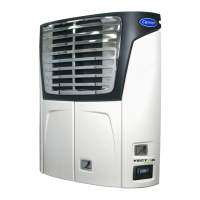8–21 62-11785
c. Diagnostics - Valve
If the valve failed pretest and passed the preceding diagnostic testing, this is an indication the valve
mechanism is damaged and the internal motor/piston assembly is to be replaced.
1. To test the valve internal mechanism, install a manifold gauge set on the suction service valve and a stepper
motor drive tester.
2. Start the unit, set the step rate to 150 steps per second and close the valve while watching the suction pressure.
Within one minute the suction pressure should begin to fall. Place the START/RUN-OFF switch in the OFF
position before the reading enters a vacuum.
3. If the suction pressure does not change, this is an indication the valve is stuck and the internal motor/piston
assembly is to be replaced.
d. Replacing The Internal Motor/Piston Assembly
1. Pump down the low side. Refer to Section 8.5.2.
2. Remove internal motor/piston assembly and replace with a new assembly and gaskets. The motor/piston
assembly should be set to 100% open when received from the warehouse. This is to ensure the valve seal is
not damaged when it is installed. Ensure the valve is fully open by using the stepper motor tester to manually
open the valve to 100% before it is installed. Ensure the gasket is installed in the body groove, and torque the
body screws 80 to 97 inch/lbs (9 to 11 Nm).
3. Leak check, evacuate & dehydrate, and charge system as required. Refer to
Section 8.5.2
,
Section 8.5.3
&
Section 8.5.4
.
e. Emergency Repair Procedures
In the event that the CSMV system has a failure and replacement components are not readily available, an
emergency, a LIMP-HOME procedure can be done as follows:
1. Install a manifold gauge set.
2. Pump down the low side. Refer to Section 8.5.2.
3. Remove the internal motor/piston assembly.
4. Loosen the Allen screw and remove the piston and screw.
5. Install the motor/piston assembly (without the piston). Torque the nut 35 to 40 ft/lb (47.5 to 54.2 Nm) or body
screws 80 to 97 inch/lbs (9 to 11 Nm) as applicable.
6. Leak check, evacuate & dehydrate, and charge system as required. Refer to Section 8.5.2, Section 8.5.3 &
Section 8.5.4.
7. Start the unit.
8. Adjust the suction service valve so that the approximate temperature is maintained. For perishable loads, it
is recommended that the adjustment be made so that available capacity is slightly larger than the load, the
unit will cycle OFF and ON.
9. Once repair parts become available, repair as required.

